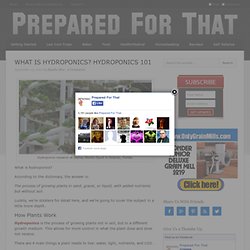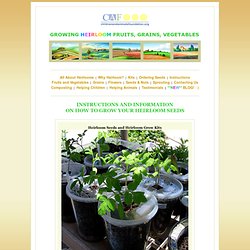

Geodesic Dome Greenhouse. The benefits of wood ash in the garden. If you have a wood stove or a fireplace, one of spring’s rituals is shoveling out the ashes.

And if you’re in tune with the philosophy of recycling plant residues back into the natural cycle of soil fertility, you’ll want a better destination for those ashes than the trash bag. Unlike the decomposed remains of leaves, stems and other green plant parts, burned wood doesn’t contain nitrogen. But it does provide phosphorous, potassium, calcium, boron and other elements that growing plants need. It’s also very alkaline and useful for raising the pH in gardens. You’ll need about twice as much of it as lime, but it will supply nutrients at the same time, and if you’re a wood-burner it’s free. Yellowing and Stunted Growth of Vegetables in Garden - Rocky Mountain Gardening Forum. Baker Creek Heirloom Seed Co. Tubtrug Colander. WHAT IS HYDROPONICS? HYDROPONICS 101 - Prepared For That. Hydroponics research at Disney World’s Epcot in Orlando, Florida.

What is hydroponics? According to the dictionary, the answer is: The process of growing plants in sand, gravel, or liquid, with added nutrients but without soil. Luckily, we’re sticklers for detail here, and we’re going to cover the subject in a little more depth. How Plants Work Hydroponics is the process of growing plants not in soil, but in a different growth medium. There are 4 main things a plant needs to live: water, light, nutrients, and CO2. Plants breathe in CO2, and split it into Carbon and Oxygen molecules. Using sunlight, the plant combines this carbon with water (H2O) to make a sugar molecule. This sugar molecule can then be combined with nutrients found in the soil to form plant tissue, so the plant can maintain itself, grow, and reproduce.
If a plant doesn’t receive these four inputs in the right amounts, the plant cannot grow optimally. Solution Culture. Blog Archive Guest Post: Beekeeping 101- How To Get Started With Bees! Beekeeping has been a part of my life for almost nine years and is one of my greatest passions.

I particularly enjoy talking about bees, helping others get started with the hobby and spreading awareness about the importance of honeybees. This post will introduce you to beginner beekeeping and how to help the honeybee even if you don’t want to keep them. I first became interested in honeybees while studying anthropology in college. The social structure of the honeybee is unlike any other living organism, and the level of organization, community and work ethic is second to none. Inside the hive, they are truly remarkable creatures. After graduating from college, I enrolled in a six-week course at a honeybee learning center just outside Vancouver, British Columbia, Canada. That next spring I jumped in headfirst and haven’t turned my back on them since. If you can answer yes to the following questions – any or all of them – then beekeeping might just “bee” the thing for you. You can have a greenhouse ANYWHERE! This greenhouse will even fit on a…
You can have a greenhouse ANYWHERE!

This greenhouse will even fit on a balcony. It's built with scrap lumber and 3 same sized storm windows. I spent no money on this greenhouse - old storm windows, leftover lumber and hinges & latch from an old door I found. I used a pallet to set the greenhouse on to keep it up off the ground. Repurpose and reuse! Framed with 2x4s. The roof of the greenhouse is another window. Super cute & tiny, yet big enough to start seeds or grow a few pots of tomatoes. Time: 2 Days Cost: $0.00 Difficulty: Moderate. Building a bottle tower for container gardening. Growing Heirloom Seeds - Natural Organic Gardening - Container & Apartment Gardening. The first thing to know, and perhaps the most important for successful gardening, is that Heirloom growing is much easier to do than you might think.

Heirloom growing is something that just about anyone can do. If by chance you don't succeed at first, try, try again. It will happen for you if you don't give up. Heirloom growing is so rewarding on so many levels. It provides the best and most amazingly delicious healthy eating for pennies, beautiful greenery and fresh plant oxygenation around you all the time, the opportunity to be close to Nature within the comfort of your own home. You can grow year round.
To start, soak your seeds overnight in a small amount of clean, fresh water so that they get a chance to absorb all the moisture they need. We like to plant two sprouts together. Below is a picture of self-contained, simple, transparent 4 by 6 inch plastic containers with nutritious volcanic pumice and super soil. The soil is reusable year after year and will retain nutrients.
Here is the greenhouse my husband made out of very inexpensive pine. I. If you have a window that could a little privacy barrier, why not add. Growing Tomatoes in the Pacific Northwest can be a challenge, so I mad.